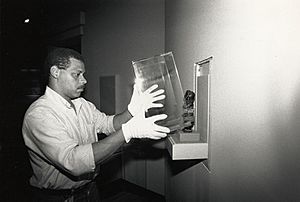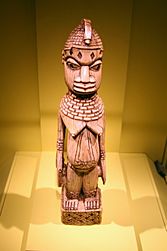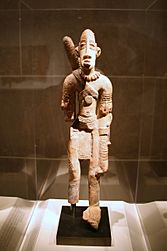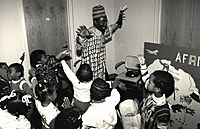National Museum of African Art facts for kids
 |
|
| Lua error in Module:Location_map at line 420: attempt to index field 'wikibase' (a nil value). | |
| Former name | Museum of African Art |
|---|---|
| Established | 1964 |
| Location | Washington, D.C., United States |
| Collections | African art |
| Collection size | 11,800 |
| Visitors | 213,000 (2016) |
| Founder | Warren M. Robbins |
| Public transit access | |
The National Museum of African Art is a special museum in Washington, D.C., part of the Smithsonian Institution. It is located on the National Mall, a famous area in the United States capital. This museum is dedicated to African art.
Its collection includes about 9,000 pieces of traditional and modern African art. These artworks come from both Sub-Saharan Africa and North Africa. The museum also has 300,000 photographs and 50,000 books. It was the first museum in the United States focused on African art. It still has the largest collection of its kind. Many people see it as a very important place for African art around the world.
The museum started in 1964. It was founded by a former diplomat named Warren M. Robbins. At first, it focused on older African art and teaching people about black cultural heritage. To make sure the museum would last, Robbins asked the United States Congress to make it part of the Smithsonian. It joined the Smithsonian in 1979. Two years later, it became the National Museum of African Art.
A new building for the museum opened in 1987. Most of this building is underground, right next to other Smithsonian museums. The museum has become more focused on scholarly research over the years. It collects important traditional and modern artworks. The museum often has temporary exhibits and special events. Its short name is NMAfA.
Contents
History of the Museum
How the Museum Started
In the late 1950s, Warren M. Robbins bought 32 pieces of African art. He found them in antique shops in Germany. In 1963, he started a group called the Center for Cross Cultural Communication. This group aimed to teach people about different cultures.
In 1964, a historic house on Capitol Hill became available. This was the former home of Frederick Douglass. Robbins used his savings to buy the house. With money from his group, he then founded the Museum of African Art.
The museum officially opened in 1964. Its first exhibit showed Robbins's collection and two other artworks. Robbins wanted the museum to focus on traditional African art. He also wanted to teach people about black cultural heritage. The museum was a friendly place for people interested in American racial politics. It fit in with the Black Arts Movement of the 1960s and 1970s. This movement worked to change how Americans viewed African cultures. Robbins called his museum "an education department with a museum attached." By 1976, the museum had 20 staff members and 6,000 objects.
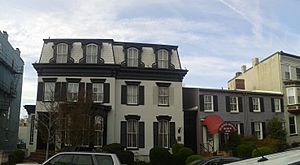
Joining the Smithsonian
Robbins wanted the museum to last a long time. So, he worked to have it join the Smithsonian Institution. The Smithsonian is a large group of museums and research centers run by the government. The United States House of Representatives agreed to this plan in 1978. Many important people supported it.
The Smithsonian officially took over the museum in 1979. They then started planning to move the collection to a bigger, proper museum building. In 1981, the museum's name changed to the National Museum of African Art.
New Leadership and Growth
In early 1983, Sylvia Williams became the museum's new director. Later that year, the Smithsonian started building a new home for the museum. This new building was mostly underground, near the National Mall. It opened in September 1987. The new space allowed for many more exhibits.
Over time, people's views on African art changed. They began to study traditional objects for their beauty and skill. Sylvia Williams led the museum with a scholarly approach. She collected important and valuable pieces. The museum's collection grew to include modern art and art from Arab North Africa. The museum's founder, Robbins, felt that the museum was focusing too much on scholarly work. He thought it was forgetting its public role.
After Williams passed away in 1996, Roslyn Walker became director in 1997. She continued Williams's work. Walker added a special gallery for contemporary art in 1997. She also helped raise money for a renovation of the museum's entrance area in the early 2000s.
Sharon Patton was director from 2003 to 2008. During her time, the museum had more shows for children.
Johnnetta Cole, a scholar and former college president, became director in 2009. She retired in March 2017. Gus Casely-Hayford, a filmmaker and scholar, became director in February 2018. In 2021, museum consultant Ngaire Blankenberg became director. She left in 2023.
In 2022, the museum returned 29 Benin Bronzes to Nigeria. These artworks were taken during the Benin Expedition of 1897.
Museum Operations
The museum is one of the smaller Smithsonian museums. Its location is somewhat hidden from the main National Mall area. This has sometimes made it harder for people to find. The museum has worked to attract more visitors and donations. In late 2016, it held its first big fundraising dinner.
Museum Architecture
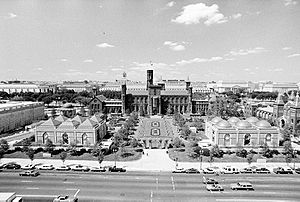
Construction for the museum's National Mall building began in 1983. This project also included the Arthur M. Sackler Gallery for Asian art. The new buildings added a lot of exhibit space. Most of this space was built underground. This was done so it would not block the view of the historic Smithsonian Institution Building, also known as the Castle. The Castle hides the museum from the National Mall.
The African art and Sackler buildings look like twin pavilions. Each has one story above ground. They both have five galleries. Only one gallery in each building has natural light. The African art building has round domes on its roof. The Sackler building has pyramids.
The African art pavilion is made of red granite. It uses circles as its main design theme. You can see round windows and a rounded entrance staircase. Inside, a curving staircase leads visitors down to the galleries. The galleries are large and can be changed to fit different exhibits. The buildings are visible from Independence Avenue. The beautiful Enid A. Haupt Garden is between them and the Smithsonian Castle.
Underground, the museum and its offices take up two levels. A third level has exhibition and education rooms. These levels are connected by an enclosed walkway with large skylights. These skylights are set into the gardens above. The pavilion was updated in the early 2000s.
In 2016, a sculpture by Yinka Shonibare called Wind Sculpture VII was placed outside the museum. It is now a permanent display.
Art Collections
The National Museum of African Art was the first museum in the United States to focus on African art. Its collection is very large. As of 2008, it had 9,000 art objects and 300,000 photographs. The objects include sculptures and masks from the 15th century. It also has modern multimedia art. The photographs include important works by Eliot Elisofon and Constance Stuart Larrabee. Elisofon covered major events for Life magazine. Larrabee photographed World War II and life in South Africa.
The museum collects items for both their traditional uses and their artistic beauty. It receives many gifts of art each year. The Washington Post newspaper said the museum is "a solid force in the international art world." It is also the main place for modern African art in the United States.
When the museum moved to the National Mall in the 1980s, its collection had over 6,000 art objects. These included sculptures, artifacts, and textiles. It also had the large Elisofon photography collection. This original collection focused on Sub-Saharan Africa. It had many pieces from the Guinea coast and Western Sudan. Some early important pieces include an Edo–Portuguese ivory spoon and an Akan gold pendant. The museum got its first budget to buy art when it joined the Smithsonian.
Within ten years, the collection grew to 7,000 traditional and modern objects from all over Africa. Under Roslyn Walker's leadership, the museum added more modern art. It opened a permanent gallery for contemporary art in 1997. That same year, Constance Stuart Larrabee gave the museum 3,000 photographs from South Africa.
In 2005, the museum received the Walt Disney-Tishman Collection. This collection had 525 artworks from many different African art styles and cultures. This was a very important gift for the museum. The museum's library also grew a lot after joining the Smithsonian. It now has 50,000 books on visual arts, history, and travel, especially books published in Africa.
In March 2022, the museum announced it would return 39 Benin Bronzes to Nigeria. These pieces were taken during a conflict in 1897. They will be displayed at the National Museum of Benin in Benin City.
Exhibitions and Programs
The museum has hosted many special exhibitions. Since joining the Smithsonian, it usually has two to three temporary exhibitions each year. In its early years, before joining the Smithsonian, the museum often borrowed artworks for its shows. As the museum grew, its exhibitions became more ambitious.
When the new building opened in 1987, the museum showed 375 artworks. These were in five different exhibits. One main exhibit was called "African Art in the Cycle of Life." It showed 88 items in seven sections. These sections followed different stages of African tribal life. For example, one section showed maternity figures, and another showed ceremonial masks. Many of these artworks were masterpieces borrowed from other museums. The exhibits aimed to show different perspectives on African art. They wanted to challenge old ideas about it.
In the late 1990s and early 2000s, the museum had shows on Egyptian modern art and textiles from Madagascar. A gift from photographer Constance Stuart Larrabee led to a special exhibition of her work. In 1998, the museum had a show about the Yoruba sculptor Olowe of Ise. This was rare for a single African artist at the time. The museum has also shown works by artists like Sokari Douglas Camp and Yinka Shonibare.
The museum has also had shows for children, like "Playful Performers." These shows were very popular. In 2004, a show called "Insights" featured 30 artworks about Apartheid in South Africa. In 2013, the museum received a large gift from Oman. This gift helped fund a series of programs focusing on arts from Oman and its connections to other cultures.
In 2015, an exhibition called "Conversations: African and African-American Artworks in Dialogue" opened. It featured artworks from the private collection of Bill Cosby and Camille Cosby. This exhibit became controversial because of public concerns about Bill Cosby. The museum's director had a long friendship with the Cosbys. The exhibit was planned to celebrate the museum's 50th anniversary. As public concerns grew, the museum put up a sign. This sign acknowledged the concerns but also asked visitors to focus on the artists and artworks in the show. The exhibit remained open.
Community Outreach
In its early years, the museum focused a lot on education. Its founder called it "an education department with a museum attached." The museum had a friendly atmosphere. It offered programs that taught about black cultural heritage. Many children from local schools visited the museum. They learned how to look at art and compare African art with modern art. School groups often took guided tours with trained docents.
In the early 1980s, the Smithsonian noticed that not many people from minority groups visited its museums. The African art museum, before moving to the National Mall, served a diverse community. It had diverse staff and popular programs for local schools. These programs included films, folk stories, and lectures. The museum also offered workshops on African weaving and drumming.
In the mid-2000s, the museum director said that many people in Washington did not know where the museum was. The museum then started having more shows for children. For a short time, more children visited the museum than adults. Around this time, the museum held about ten special events each year. In 2016, the museum worked hard to attract more visitors and donations.
See also
 In Spanish: Museo Nacional de Arte Africano para niños
In Spanish: Museo Nacional de Arte Africano para niños





